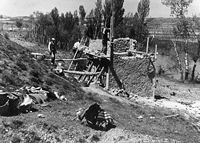
|  |
The
Spanish Earth
|

|
|
1937
/ USA / B&W / 52 min / 35mm
Director: Joris Ivens
Camera: John Ferno
Editor: Helen van Dongen
Music: Marc Blitzstein, Virgil Thomson
Commentary: Ernest Hemingway
Production company: Contemporary Historians, Inc. |
The production company Contemporary Historians was set up to raise
money for a documentary filmed in Spain on the civil war raging there.
With John Ferno and initially with John Dos Passos, who, when he left
the crew, was replaced by Ernest Hemingway, Joris Ivens went to Fuenteduena,
near Madrid, to film on the front lines of the Republican armies.
It is one of the major films on the Spanish Civil War and one of the
most important films in Ivens's career. As in many other films Ivens
finds a balance between the daily lives of people and their struggles
to survive. The strong photography, mainly by John Ferno, combined
with powerful editing by Helen van Dongen and the commentary by Ernest
Hemingway, make the film a masterpiece of documentary filmmaking.
THE
SPANISH EARTH, THE SPANISH EARTH, AND TERRE D'ESPAGNE
Compiling a filmography of the films of Joris Ivens, one of the next
projects of the Joris Ivens Foundation, will not be an easy job. A
simple list of film titles will not suffice. Many of his films have
been released in different versions or have been distributed with
minor or major cuts, thanks to censorship, distributors, and sometimes
also thanks to Ivens himself. The tale of the existence of several
different versions of The Spanish Earth will help illustrate
this.
The most well-known version of this film features Ernest Hemingway's
commentary narrated by Hemingway himself. This was the version that
went into distribution in 1937. The first public screening was on
July 13 of that year at the Los Angeles Philharmonic Auditorium. The
original plan called for the commentary, written by Hemingway, to
be read by Orson Welles, suggested for this role by Archibald MacLeish,
one of the founding members of Contemporary Historians. Hemingway
had written a lengthy commentary, which already had been significantly
shortened by Joris Ivens before Orson Welles received it. Welles thought
that the commentary was still redundant in some places, and some minor
changes were made before Welles recorded it. This recording and the
sound editing by Helen van Dongen were finished in June 1937, and
a few private screenings were organized in and around Los Angeles
to solicit reactions to the film. Some of the Contemporary Historians,
including Lillian Hellman, Herman Shumlin, and Dorothy Parker, thought
that Orson Welles's voice was too smooth to be matched with the powerful
images on the screen. It was decided that Hemingway himself ought
to read his own commentary. He, after all, had direct experience on
the front lines. According to critiques, this sounded considerably
more sincere and much less "polished" than Welles's version.
On July 8, Ivens, Hemingway, and Martha Gellhorn were invited to the
White House to show the film to the President and Mrs. Roosevelt.
They used the Welles version for this screening, perhaps because the
sound editing for the Hemingway version, which premiered only five
days later, wasn't finished yet.
Thanks to censorship throughout the world there are still other versions.
In the East German version, for instance, the scene with Gustav Regler
was cut out, because Regler, an anti-fascist writer, had rejected
communism. The most infamous mutilation of the film was made in France
by Jean Renoir in 1938. The film was shortened by 10 minutes by removing
the all-too-explicit critique of Nazi Germany in order not "to
offend the neighbors."
Cuts were also made in other countries. It is probably clear by now
that thanks to changes made in post-production, distribution, and
in censorship, one title can sometimes hide the existence of many
alternate versions of a film.[Kees Bakker]
A
TOPICS
|
  |
|
before  next next |
COPYRIGHT:Yamagata International Documentary Film Festival Organizing Committee
|